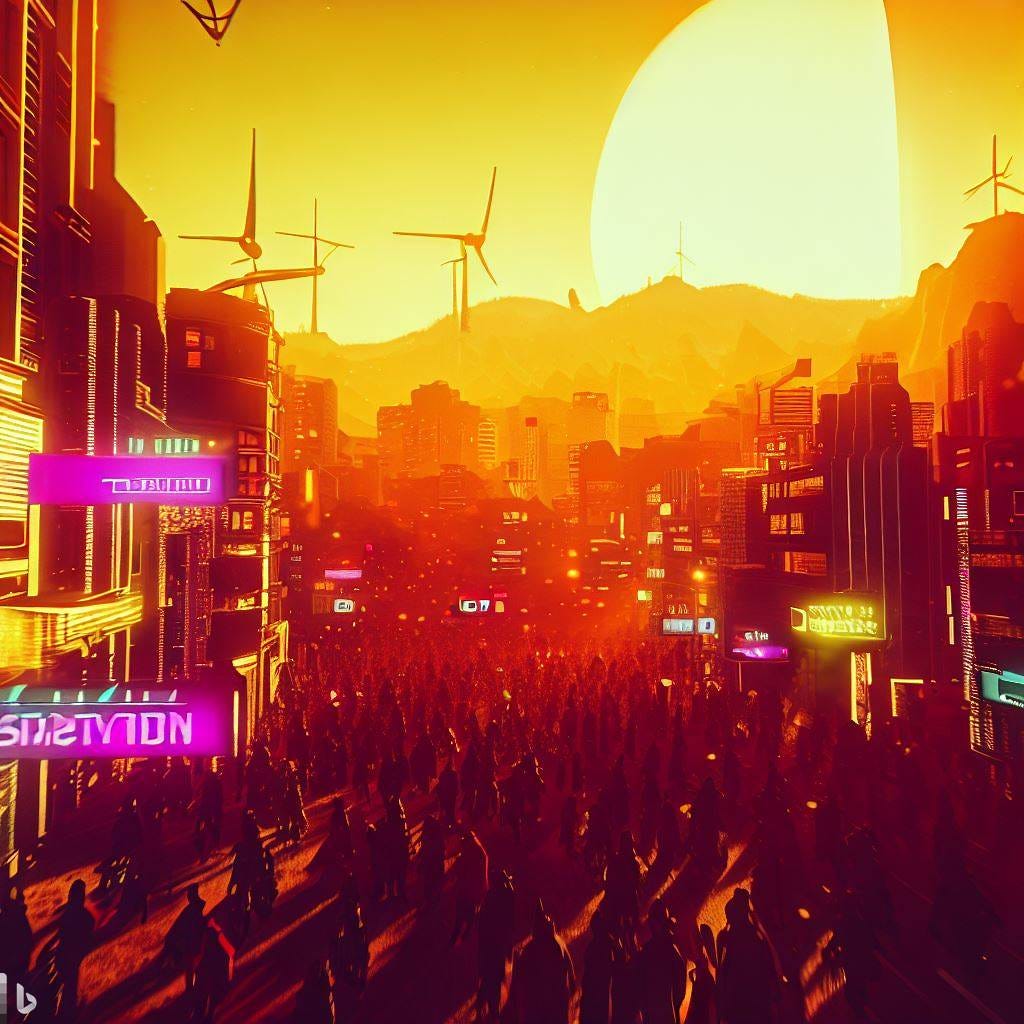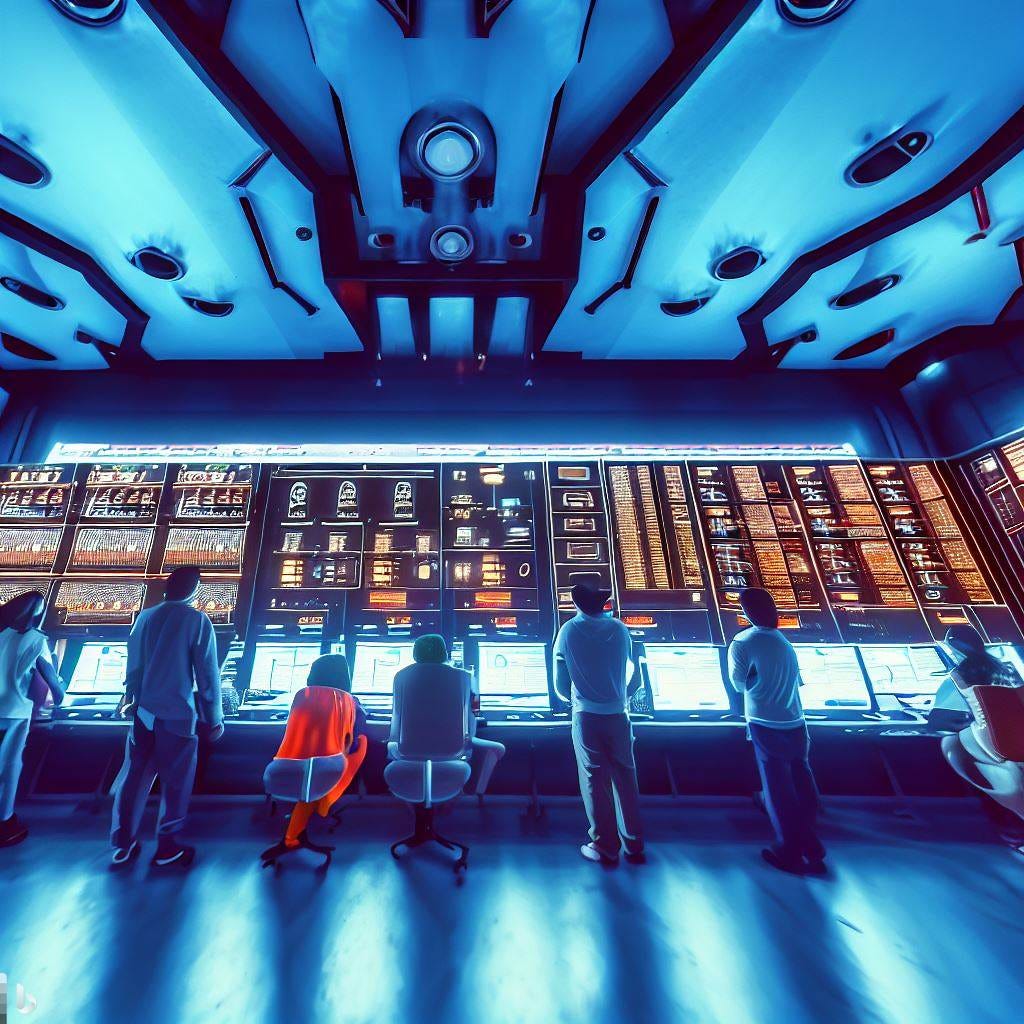The Heat is On: An Adventure into IntelliSphere's AI-Enhanced Grid Battle
How will the utility of the future handle extreme heat waves?
August 9, 2035. It’s been 4 years since the ambitious merger of several small utility providers into IntelliSphere (“IS”), a fully integrated energy company serving over 6 million customers in the urban expanse of Crescent Heights.

The transition from coal and methane to solar, wind, and geothermal has accelerated in recent years due to significant government investment in everything from R&D to workforce development. Modular, melt-down proof nuclear reactors have faced regulatory hurdles and are still operating in small-scale pilot programs in other parts of the country.
While air quality has improved, reliability has been a challenge with more frequent rolling blackouts. IS customers are disgruntled.
The “grid collapse” in 2032 resulted in 11 days of perpetual system disruption. The media never misses an opportunity to surface this any time the weather gets a bit warmer than average - their Engagement Algorithm ranks the “Blackout Bonanza of 32” as their most profitable Content Byte, driving the most clicks and thus ad revenue of their entire library of Outrage Events. #IneptiSphere really caught on.
Things have been improving at IS due to the integration of various “smart systems” to help balance energy supply and demand. The entire utility infrastructure now lives on a cellular-connected, interoperable platform. Advanced automated meters monitor everything from Power Quality to Peak Demand. Line sensors continuously check voltage health in real-time. 96% of all homes and businesses have at least one grid-connected, load-intensive device such as thermostats and hot water heaters, whose usage can be remotely managed by the utility.
IntelliSphere is about to face its biggest challenge: in 3 days, a heat wave is expected to bring record temperatures, with highs forecasted to hit over 120°F. The public is worried about the ability of IS to handle the heat.

Forecasting Impacts
Grace is IntelliSphere’s Grid Management Manager. With news of the impending heat wave, she gets to work.
Grace receives the Final High-Confidence Forecast from the utility’s Deep Learning (DL) and Machine Learning (ML) models. These models have analyzed vast amounts of meteorological data, grid capacity data, and meter load-profile data to estimate the heat wave’s potential impact on energy production and demand.
The ML model examines relationships between temperature increases and energy consumption spikes, while the DL model employs neural networks to analyze complex interactions, such as the heat wave's impact on solar panel efficiency and wind turbine output.
Together, these models provide Grace with a High-Confidence forecast of how the heat wave might impact key components of the grid: renewable energy production, energy storage, and transmission & distribution infrastructure.
Digital Twin Simulations
With the Final High-Confidence Forecast in-hand, a Digital Twin Simulation models a virtual replica of the city's grid, taking into account the projected effects of the heat wave on energy production and consumption.
The Digital Twin Simulation utilizes Decision Support Algorithms to assess high-probability scenarios, considering labor, financial costs, and possible outages. This analysis generates a feasible Resource Plan to tackle the heat wave's anticipated impacts.
The first step is preventative maintenance - what can be done ahead of time to help prevent equipment failure? Field techs have a backlog of work to do, but that work is prioritized according to near-term extreme weather events.
To address this, Genetic Algorithms and Support Vector Machines are employed to prioritize field maintenance work, given the likelihood of equipment failure under increased demand during a heat wave.
Demand Management Strategy
Meanwhile, Grace's colleague Sam, the Demand Response Coordinator, instructs the DR Reinforcement Learning Agent (DR-RLA) to develop an "Optimal Demand Algorithm" with the goal of ensuring demand does not overwhelm supply during the heat wave. The Reinforcement Learning Agent analyzes different demand response strategies and evaluates their effectiveness in maintaining grid stability during the heat wave.
The algorithm recommends a 97% aggregate charge for grid storage systems to avoid widespread outages. To achieve this, it formulates a Demand Reduction Incentive Plan (DRIP) that minimizes customer disruption and accounts for heightened demand just prior to the heat wave, as thermostats pre-emptively cool homes and businesses.

The “Comfort vs. Money” Trade Off
Lots of IS customers struggle to pay their bills. Many receive financial assistance, but many others fall through the cracks. These customers already keep their AC at 80°F in the summer. They have no interest turning it back to 85°F.
Other customers will happily exchange sweat for money. Josh Daniels is one of them.
Josh has lived in Crescent Heights his whole life. Like everyone else, he relies on LifeSync, the AI-powered Virtual Assistant app that manages everything from meal-planning for optimal health, to customized digital entertainment streams.
IntelliSphere's AI agent is integrated into Josh's LifeSync, as it is with all of their customers. Though it often goes unnoticed, the latest notification grabbed his attention—a severe heat wave is approaching that could cause widespread power outages.
Being a mere 24 years old, Josh is not concerned. In fact, he’s quite excited. He doesn’t care about IntelliSphere or how utilities work, he just wants cold beer and hot showers. And sometimes IS pays him not to use energy. What a concept!

Tailored Tiers: Personalized Energy Incentives & Rising Energy Costs
When customers open an account with IS, they are placed on a “demand incentive tier” based on demographic and social data. This groups customers by their willingness to be compensated for providing IntelliSphere the ability to adjust their energy usage periodically, for short amounts of time.
Customers can manually change this tier at any time, though there are some restrictions for age and health related reasons. These customers are in the “do not adjust” tier and must go through lengthy appeals process to change tiers. While obesity rates have dropped due to the Obesity Reduction Act (ORA) of 2028, which made Ozempic freely available and Novo Nordisk the second most valuable company in the world, underlying metabolic health has only continued to deteriorate.
Josh has opted for the “high-allowable reduction” tier. This gives IS maximum flexibility to remotely adjust his power during demand response events. From Josh’s point of view, this is an opportunity to make a little extra money. He will either sit and sweat a little, or venture out to the Crescent Heights Library where they don't turn down the cool air.
Since so much of the population is elderly or has a chronic illness that heat exasperates, the amount of money IntelliSphere is willing to spend per eligible customer has risen significantly, creating a stratified customer base where the young and healthy are paid in exchange for the comfort of everyone else. This has caused rate increases for customers in the “do not adjust” tier, putting more of these customers on fixed incomes in arrears. It’s a problem IS and the City have yet to resolve.
Intelligent Oversight: Enhanced Power Monitoring
The digital twin simulation identified one high probability risk: if temperatures reach at least 121°F for over 4 hours, there's a 68% chance of equipment failure, leading to outages. Field technicians inspected the transformers and power lines in this area, but found nothing of concern.
Grace and her team turn to their control system - an AI-enabled SCADA platform, upgraded to utilize Deep Learning algorithms for grid management. (A SCADA system helps control and manage the power grid by collecting data and making adjustments to keep electricity flowing smoothly).

Strategically placed sensors on power lines feed vital data into the SCADA systems: voltage, current, temperature, and power quality measurements. These are all analyzed to detect early warning signs of potential outages.
As the temperature in Crescent Heights climbs, the sensors detect abnormal temperature increases in a grid section, signifying a potential risk of equipment failure. The SCADA system's AI algorithms quickly identify high-load on a specific transformer that could destabilize the grid. To avoid a power outage, power demand must be reduced quickly.
Targeted Demand Reduction
Josh is sitting at home, his Apple iVision AR headset comfortably resting over his brow. Barreling through deep space, he is engrossed in the infectious enthusiasm of Carl Sagan, who is pontificating on the mysteries of the universe. Josh is preparing for his “Foundations of the Cosmos” oral assessment exam in a mere 13 days.
His LifeSync receives a level 9 notification, jolting him out of Saturn's orbit, back to his cluttered living room. He removes his headset. His smart watch is vibrating ceaselessly until eye contact is made and the message is read. It is an offer from IS - turn off all power consuming devices for the next 4 hours, except for the refrigerator and freezer in exchange for a bill credit nearly equal to last month’s energy bill. “Money in the bank…” Josh mutters under his breath.
He clicks the Accept button, confirms his identity with a retina scan on his smart glasses, and his buzzing house suddenly becomes eerily silent. His energy consumption has dropped 90%.
Thousands of others receive a similar, but personalized message from IS. Many accept the offer and shut off their power. Many do not.
The SCADA system determines that demand has been reduced enough to divert power away from the faulty transformer. At the same time, power has been re-routed from parts of the grid where demand has dropped to parts that were at risk of losing power.
With the help of artificial intelligence, financial incentives, and a little bit of luck - no outages occurred during “The Great Furnace of ‘35.” Maybe now the media will give IntelliSphere credit and lay off the Outrage Bait.
I wouldn’t bet on it.
Is this a realistic view of the future? Maybe. Safety and reliability in utilities are non-negotiable. I expect we will see AI + “human-in-the-loop” to augment existing processes for quite some time, rather than outright worker replacement.
Some tools make sense now, like digital twin simulations. Utilities actually use a lot of intelligence already, like automated meters (it’s in the name - “automated”!) Other techniques that touch critical infrastructure will be vetted in “safer” industries or highly controlled conditions where risks don't entail grid collapse.
Only after significant testing in dev environments, then pilot programs, will we see anything resembling full AI integration into utilities. When that happens, let's hope we are as lucky as the citizens of Crescent Heights.



